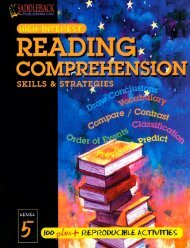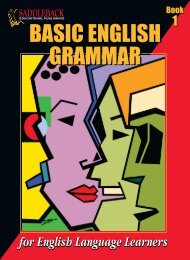Download Sample - SADDLEBACK Educational Publishing
Download Sample - SADDLEBACK Educational Publishing
Download Sample - SADDLEBACK Educational Publishing
You also want an ePaper? Increase the reach of your titles
YUMPU automatically turns print PDFs into web optimized ePapers that Google loves.
Contents<br />
To the Student. .....................................................4<br />
lesson 1: Using Vivid Nouns. ........................................6<br />
lesson 2: Using Vivid Verbs. ........................................8<br />
lesson 3: Using Vivid Adjectives. . . . . . . . . . . . . . . . . . . . . . . . . . . . . . . . . . . . 10<br />
BASIC SKILLS PRACTICE: Developing an Outline. ..........................12<br />
lesson 4: Using Vivid Adverbs. .....................................14<br />
lesson 5: Eyewitness: Firefighter’s Heroic Rescue ......................16<br />
lesson 6: Eyewitness: Fashion Show. ................................18<br />
BASIC SKILLS PRACTICE: Sentence Structure. .............................20<br />
lesson 7: Eyewitness: Moon Landing. ................................22<br />
lesson 8: Clothing of the Future. ....................................24<br />
lesson 9: Story Settings. ...........................................26<br />
BASIC SKILLS PRACTICE: Usage: Formal and Informal English. ..............28<br />
lesson 10: Describing a Mood. ......................................30<br />
lesson 11: Thoughts of a Pet. .......................................32<br />
lesson 12: A Scary Place. ..........................................34<br />
BASIC SKILLS PRACTICE: Commas. ......................................36<br />
lesson 13: On Vacation. ...........................................38<br />
lesson 14: Describing a Minor Event. ................................40<br />
lesson 15: Catalog Products. .......................................42<br />
BASIC SKILLS PRACTICE: Figurative Language ............................44<br />
lesson 16: Sales Brochure. .........................................46<br />
lesson 17: Sensory Descriptions. ....................................48<br />
lesson 18: Describing Seasons: Winter and Summer. ...................50<br />
BASIC SKILLS PRACTICE: Verb Voices. ...................................52<br />
lesson 19: Describing Seasons: Fall and Spring. .......................54<br />
lesson 20: Armchair Travel: A Foreign City. ..........................56<br />
lesson 21: Fun with Hyperbole. .....................................58<br />
BASIC SKILLS PRACTICE: The Writing Process: Developing Ideas. .............60<br />
FINAL PROJECT: A Memorable Experience ...............................62<br />
Teacher’s Guide and Answer Key. .........................................65
To the Student<br />
How about it?<br />
Can you count on your<br />
writing skills to make<br />
your meaning clear?<br />
Check yourself out<br />
by answering the<br />
following questions!<br />
w Can you give other people easy-to-follow directions and explanations?<br />
examples: how to tape a TV show<br />
how a bill becomes law<br />
w Can you describe something clearly enough to create a vivid image<br />
in the minds of your audience?<br />
examples: a dramatic thunderstorm<br />
a movie star’s mansion<br />
w Can you tell a story so well that your audience is fascinated from<br />
beginning to end?<br />
examples: the history of baseball<br />
the world’s worst date<br />
w Can you usually persuade others to accept your opinion or take<br />
some kind of action?<br />
examples: see a certain movie<br />
register to vote<br />
4—descriptive writing • © Saddleback <strong>Educational</strong> <strong>Publishing</strong> • www.sdlback.com
To the Student<br />
Saddleback’s WRITING 4 series will improve your written work—<br />
no matter what your purpose is for writing. If you make your best<br />
effort, the result will surprise you. You’ll discover that putting words<br />
on paper isn’t that much different from saying words out loud. The<br />
thought processes and grammatical structures are the same. Writing<br />
is just another form of expression; skill develops with practice!<br />
Competent writers do better at school and at work. Keep that in mind<br />
as you work your way through these books. If you learn to write well,<br />
you’re more likely to succeed in whatever you want to do!<br />
Are you ready to go for it?<br />
Follow me—I’m off and running!<br />
© Saddleback <strong>Educational</strong> <strong>Publishing</strong> • www.sdlback.com • descriptive writing—5
Lesson<br />
1 Using Vivid Nouns<br />
Nouns are words that name persons, places, things, or events. Good writers choose<br />
nouns that are specific rather than general. The word dog, for example, does not<br />
give the reader an exact mental picture. A specific noun such as whippet, greyhound,<br />
Dalmatian, or cocker spaniel would create a much more precise image.<br />
A. Rewrite each sentence, replacing the underlined word with a more specific<br />
noun that creates a clearer picture.<br />
1. Please pass the vegetables.<br />
__________________________________________________________________________<br />
2. We went to a restaurant for dinner on Saturday.<br />
__________________________________________________________________________<br />
3. After dinner, we split a dessert.<br />
__________________________________________________________________________<br />
4. Patrick bought a new car.<br />
__________________________________________________________________________<br />
5. Jean lives in a place with an ocean view.<br />
__________________________________________________________________________<br />
6. The game started at 3 o’clock.<br />
__________________________________________________________________________<br />
7. We saw an interesting animal at the zoo.<br />
__________________________________________________________________________<br />
8. Tom and Bob fished from a boat.<br />
__________________________________________________________________________<br />
9. Gloria’s pet is cute and friendly.<br />
__________________________________________________________________________<br />
10. The machine made a lot of noise.<br />
_________________________________________________________________________<br />
6—descriptive writing • © Saddleback <strong>Educational</strong> <strong>Publishing</strong> • www.sdlback.com
Lesson 1 • Using Vivid Nouns<br />
B. This picture shows a typical day in a park. Suppose you want to describe this<br />
scene to someone else. Where would you start? You might begin with vivid nouns.<br />
Make a list of nouns that could be used in a description of this picture.<br />
_____________________<br />
_____________________<br />
_____________________<br />
_____________________<br />
_____________________<br />
_____________________<br />
_____________________<br />
_____________________<br />
_____________________<br />
_____________________<br />
_____________________<br />
_____________________<br />
C. Now use some or all of the nouns you listed to write a description of the picture.<br />
Make sure your nouns are specific enough to help your reader visualize the scene.<br />
_____________________________________________________________________________<br />
_____________________________________________________________________________<br />
_____________________________________________________________________________<br />
_____________________________________________________________________________<br />
_____________________________________________________________________________<br />
_____________________________________________________________________________<br />
_____________________________________________________________________________<br />
_____________________________________________________________________________<br />
_____________________________________________________________________________<br />
_____________________________________________________________________________<br />
_____________________________________________________________________________<br />
_____________________________________________________________________________<br />
_____________________________________________________________________________<br />
© Saddleback <strong>Educational</strong> <strong>Publishing</strong> • www.sdlback.com • descriptive writing—7
Lesson<br />
2 Using Vivid Verbs<br />
Good writers use strong, specific verbs to express action. Why? Precise verbs make<br />
it easier for the reader to imagine the action. Sometimes, strong verbs can give clues<br />
about a character’s motivations or feelings. To see how a vivid verb can clarify meaning<br />
and bring a picture into focus, compare these two sentences:<br />
The football team came onto the field for their final game.<br />
The football team bolted onto the field for their final game.<br />
Notice that the verb bolted gives the reader a sense of the players’ determination.<br />
It also helps you imagine how emotionally charged up the team was.<br />
A. Rewrite each of the following sentences, replacing the underlined word with a<br />
more vivid verb.<br />
1. The couple moved on the dance floor.<br />
__________________________________________________________________________<br />
2. Allan went out the front door.<br />
__________________________________________________________________________<br />
3. Barbara got out of bed at 6 o’clock in the morning.<br />
__________________________________________________________________________<br />
4. The child walked through the rain puddles.<br />
__________________________________________________________________________<br />
5. The lioness looked for a meal for her family.<br />
__________________________________________________________________________<br />
6. Chris drank a glass of ice water.<br />
__________________________________________________________________________<br />
7. The fat cat slept by the fire.<br />
__________________________________________________________________________<br />
8. All of a sudden, the police came in the door.<br />
__________________________________________________________________________<br />
9. The out-of-control car went into the concrete wall.<br />
__________________________________________________________________________<br />
10. The hungry man ate a sandwich.<br />
__________________________________________________________________________<br />
8—descriptive writing • © Saddleback <strong>Educational</strong> <strong>Publishing</strong> • www.sdlback.com
Lesson 2 • Using Vivid Verbs<br />
B. This picture shows a typical scene at a circus. Suppose you want to describe the<br />
picture to someone else. Where would you start? You might begin with vivid verbs.<br />
Make a list of verbs that could be used in a description of this picture.<br />
_____________________<br />
_____________________<br />
_____________________<br />
_____________________<br />
_____________________<br />
_____________________<br />
_____________________<br />
_____________________<br />
_____________________<br />
_____________________<br />
_____________________<br />
_____________________<br />
C. Now use some or all of the verbs you listed in a written description of the picture.<br />
Make sure your verbs are specific enough to help your reader visualize the scene.<br />
_____________________________________________________________________________<br />
_____________________________________________________________________________<br />
_____________________________________________________________________________<br />
_____________________________________________________________________________<br />
_____________________________________________________________________________<br />
_____________________________________________________________________________<br />
_____________________________________________________________________________<br />
_____________________________________________________________________________<br />
_____________________________________________________________________________<br />
_____________________________________________________________________________<br />
_____________________________________________________________________________<br />
_____________________________________________________________________________<br />
_____________________________________________________________________________<br />
© Saddleback <strong>Educational</strong> <strong>Publishing</strong> • www.sdlback.com • descriptive writing—9
Lesson<br />
3 Using Vivid Adjectives<br />
Adjectives are words that give more information about nouns or pronouns. Writers<br />
use adjectives to describe colors, shapes, and sizes as well as tastes, sounds,<br />
smells, and feelings. Read the two example sentences. Notice how adjectives help<br />
the reader visualize what is being described:<br />
Isabel purchased a thick green blanket.<br />
Myron served a hearty vegetable stew.<br />
A. Read each sentence. First, circle all adjectives that describe colors, shapes,<br />
or sizes. Then rewrite each sentence, changing the adjectives to create<br />
a very different visual picture. The first one has been done for you.<br />
1. Daria wore a shimmery pastel shawl.<br />
Daria wore a tattered brown shawl.<br />
__________________________________________________________________________<br />
2. Dennis painted a large red flower on the round canvas.<br />
__________________________________________________________________________<br />
3. The bright blue butterfly hovered over the delicate white orchids.<br />
__________________________________________________________________________<br />
4. Rocko is a tiny white puppy.<br />
__________________________________________________________________________<br />
B. Read each sentence. First, circle all adjectives that describe sounds, tastes,<br />
smells, or feelings. Then rewrite each sentence, changing the adjectives to<br />
create a very different visual picture.<br />
1. The noisy children played in the fragrant garden.<br />
__________________________________________________________________________<br />
2. The hungry man wolfed down the spicy enchiladas.<br />
__________________________________________________________________________<br />
3. Maria was too tired to enjoy the festive celebration.<br />
__________________________________________________________________________<br />
4. A quiet hush fell over the mournful crowd.<br />
__________________________________________________________________________<br />
10—descriptive writing • © Saddleback <strong>Educational</strong> <strong>Publishing</strong> • www.sdlback.com
Lesson 3 • Using Vivid Adjectives<br />
C. This picture shows a typical scene at a campsite. Suppose you want to describe the<br />
picture to someone else. Where would you start? You might begin with vivid adjectives.<br />
Make a list of adjectives that could be used in a description of this picture.<br />
_____________________<br />
_____________________<br />
_____________________<br />
_____________________<br />
_____________________<br />
_____________________<br />
_____________________<br />
_____________________<br />
_____________________<br />
_____________________<br />
_____________________<br />
_____________________<br />
D. Now use some or all of the adjectives you listed in a written description of the picture.<br />
Make sure your adjectives are specific enough to help your reader visualize the scene.<br />
_____________________________________________________________________________<br />
_____________________________________________________________________________<br />
_____________________________________________________________________________<br />
_____________________________________________________________________________<br />
_____________________________________________________________________________<br />
_____________________________________________________________________________<br />
_____________________________________________________________________________<br />
_____________________________________________________________________________<br />
_____________________________________________________________________________<br />
_____________________________________________________________________________<br />
_____________________________________________________________________________<br />
_____________________________________________________________________________<br />
_____________________________________________________________________________<br />
© Saddleback <strong>Educational</strong> <strong>Publishing</strong> • www.sdlback.com • descriptive writing—11
















